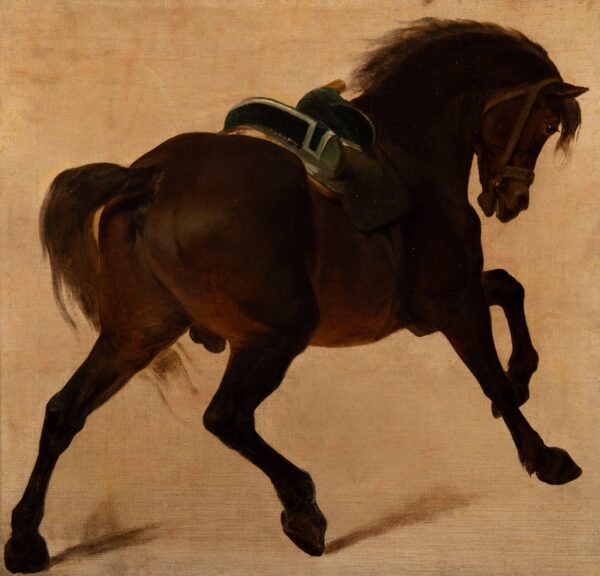Stallion, c. 1810
Oil on canvas, H. 0.57 m; W. 0.59 m
Provenance: Private collection
RELATED WORK:
Antoine Jean Gros, Battle of the Pyramids. 21 July 1798, 1810, oil on canvas, H. 3,89 m ; W. 5,11 m, Versailles, musée national des châteaux de Versailles et de Trianon.
Antoine Jean Gros (1771-1835) was a precocious talent and pupil of David from the early age of fifteen. However, he never won the Grand Prix. He went to Northern Italy, including Genoa, at his own expense, where he stayed for several years, and studied the art of Rubens. In 1796, he met the future Empress Josephine who brought him to Milan to introduce him to Bonaparte. Gros was then employed in the army and became familiar with military life in this way. After returning to Paris, he specialized in the realistic depiction of the most glorious military events of the Consulate and the French Empire. Gros was able to innovate in the rendering of movement and the effect of colour, and in this way developed a clearly modern form of history painting.
A battle painter must necessarily be talented and have a particular interest in the depiction of horses, as their impulsiveness and vigour are essential in these images. Without nurturing a passion for horses as exclusive as his future pupil Géricault would do, Gros nevertheless had a strong attraction for drawing horses that had started in his youth.[1] His first equine studies reveal so much skill that it must be assumed that he practiced this type of representation assiduously.
Our painting is a lively study of an Arabian stallion, showing a concave profile and arched neck. This horse’s vigour, the treatment of the light with small touches on the Arabian saddle and its metal parts, the movement of the horse’s tail are close to Gros. These elements can be compared with the Battle of the Pyramids,[2] painted for the Emperor’s hall at the Luxembourg Palace and exhibited at the 1810 Salon. Gros had received the commission for it on 16 August 1809,[3] and painted the composition in a vertical format, which was only enlarged with pieces of canvas on the sides under Louis Philippe. Gros may have used our study to paint Joachim Murat’s dark coated horse in the centre towards the left of the composition.
Gros kept several horse studies in his studio, which were stored among early works and sketches which he liked especially. Hence, in his posthumous inventory published by Valérie Bajou, there are several references: no. 661: “Cheval de Mamelouk, prisé cent francs [Mameluke horse, valued one hundred francs]”, and no. 663: “Deux études de Chevaux arabes, prisés cent francs [two studies of Arabian horses, valued one hundred francs]”.[4] Some of Gros’s horse studies also appear in the posthumous sale of his pupil, Auguste Debay (1804-1865)[5] who, in accordance with Gros’s wishes, finished the enlargement of the Battle of the Pyramids in 1835-1836.
We are grateful to Valérie Bajou for her help in the preparation of this entry. Our painting will be included in her forthcoming catalogue raisonné of the work of Antoine-Jean Gros that will be published by Arthéna.
[1] Jean-Baptiste Delestre, Gros. Sa vie et ses ouvrages, 2nd edition, Paris, 1867, p. 12 (ill.)
[2] Antoine Jean Gros, Battle of the Pyramids. 21 July 1798, 1810, oil on canvas, H. 3,89 m ; L. 5,11 m, Versailles, Musée National des Châteaux de Versailles et de Trianon.
[3] Manfred Heinrich Brunner, Antoine-Jean Gros. Die napoleonischen Historienbilder, PhD dissertation Bonn University, 1979, p. 291 and note 669.
[4] Valérie Bajou and Sidonie Lemeux-Fraitot, Inventaires après décès de Gros et de Girodet, Paris, VBSLF, 2002, p. 79-80.
[5] Posthumous sale of Auguste Debay, Paris, 24-27 May 1865, no. 34 and 35. We are grateful to Valérie Bajou for this information.

